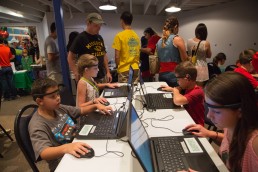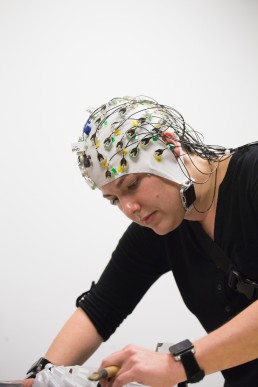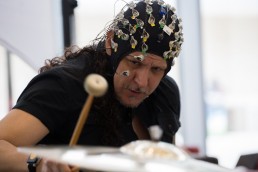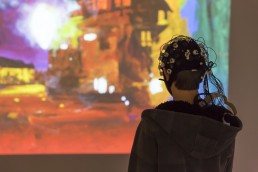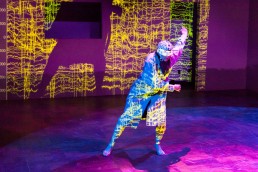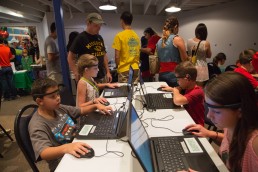Minecraft project
The Project is aimed at investigating the brain dynamics of children playing Minecraft – a creative game that enable players to build 3D constructions using textured cubes in a virtual world; to investigate the feasibility of assaying the neural responses associated with creative game playing in a museum setting and to identify differences in brain activity as a function of age, gender, and gaming experience and identify optimal artifact removal algorithms to clean the available data. Scalp electroencephalography (EEG) and head motion were acquired using off-the-shelf, low-cost, mobile brain-body imaging (MoBI) technology that limited recording to electrodes in the anterior and the temporal scalp areas.
Demographics Information
232 children (166 males/ 66 females) aged 6 to 16 years-old. Information about age, gender, race and level of expertise in playing Minecraft was collected from children and is saved in a separate excel file.

Hardware
Muse Headset
Available Data
-3 axis accelerometer sampled at 50 Hz
-4 channel EEG data (namely, TP9, AF7, AF8, and TP10) sampled at 220 Hz
-meta data including quality bits for each electrode, sampled at 10 Hz
Experimental design
Baseline condition: Looking at a white wall with eyes open. Children were asked to avoid body movements.
Task condition: Play Minecraft for up to 20 minutes while EEG and acceleration data would be recorded. There were no restrictions imposed on the children and they were allowed to play on their will to elicit and capture their natural response.
Data Records
The raw and the metadata from 171 subjects along with the excel sheet containing their demographic information can be obtained by filling out the following form and submitting a request to us. The subject number is referenced to the subject ID.The data associated with each individual subject(named with respect to the subject number) has been saved under a single variable(.mat file). Each individual dataset is further organized in the following way :
1. EEG : matlab structure containing the raw and meta data associated with the 4 channel EEG.
(a) EEG.data : a matlab variable containing the raw EEG data from the 4 channels (in the order TP9,AF7,AF8,TP10).
(b) EEG.timestamp : a matlab variable containing the timestamp associated with the EEG data.EEG was sampled at 220 Hz.
For the first 88 subjects, the baseline and task periods were identified from the accelerometer data and they have 4 additional entries corresponding to baseline and task, start and end sample points.
(c) EEG.baseline_start : a matlab variable containing the sample number associated with the start of baseline condition.
(d) EEG.baseline_end : a matlab variable containing the sample number associated with the end of baseline condition.
(e) EEG.task_start : a matlab variable containing the sample number associated with the start of task condition.
(f) EEG.task_end : a matlab variable containing the sample number associated with the end of task condition.
2. ACC : matlab structure containing the raw and meta data associated with the 3 axis head acceleration.
(a) ACC.data : a matlab variable containing 3 axis accelerometer data
(b) ACC.timestamp : a matlab variable containing the timestamp associated with the accelerometer data. Accelerometer data was sampled at 50 Hz.
3. Metadata : matlab structure containing the signal quality and demographics information associated with each subjects.
(a) Metadata.is_good : a matlab variable containing the boolean meta data provided by Muse which is a strict data quality indicator for each individual channels; 0 = bad , 1 = good. The first column corresponds to the timestamp while the next four corresponds to each channels (TP9,AF7,AF8,TP10). It was sampled at 10 Hz.
(b) Metadata.horseshoe : a matlab variable containing the meta data provided by Muse which is a data quality indicator for each individual channels; 1 = good, 2 = ok,>= 3 bad. The first column corresponds to the timestamp while the next four corresponds to each channels (TP9,AF7,AF8,TP10). It was sampled at 10 Hz.
(c) Metadata.Info : a matlab cell array containing the demographic and electrode contact information associated with that subject. The column corresponds to subject ID, age, gender, race, ethnicity, grade, class, frequency of playing Minecraft and percentage of time of good contact respectively.
Acknowledgment
We also acknowledge the logistical support of all members of the Noninvasive Brain-Machine Interface Systems Laboratory who assisted with the data collection at the Children’s Museum of Houston. This work could not have been done without the support of Julia Banda, Gretchen Schmaltz, and Neelam Damani, Director of Gallery Education at the Children’s Museum of Houston.We also acknowledge the support of graduate, REU, SURF and Methodist Academy students.
Please fill in the following form and submit a request to obtain the dataset.
Exquisite Corpse - Visual Artists
Artists wore skullcaps fitted with EEG electrodes and inertial sensors as they played Exquisite Corpse - the collaborative, chance-based game made famous by the Surrealists in the 1920’s. The
performance-study seeks to uncover clues to what happens in the brain as people create and contemplate art. Working simultaneously before a live audience, each artist has 15 minutes to begin creating an artwork. After 15 minutes, their work-in-progress is concealed with a cloth, leaving only a small portion exposed. The artists then rotate stations and take turns adding to each other’s creations for two additional 15-minute increments. Their brain activity is projected onto a nearby screen as audience members watch and also contribute their MoBI data.
[soliloquy id="429"]
[huge_it_videogallery id="1"]
Exquisite Corpse - Musicians
Wearing skullcaps equipped with sensors, different musicians play a variation of Exquisite Corpse, a collaborative, chance-based game made famous by the Surrealists in the 1920s — in which they play saxophones and drums instead of drawing. It is a collaboration between Houston Community College (HCC), Houston-based artists, Blaffer Art Museum, and the University of Houston’s Noninvasive Brain-Machine Interface Systems Laboratory, seeking clues to what happens in the brain as people create, perform, and contemplate art in a variety of disciplines.
The study is funded by the National Science Foundation (#BCS 1533691) and led by engineering professor Jose Luis Contreras-Vidal — to study connections between the brain and creativity, expression, and the perception of art.
[soliloquy id="411"]
Brain on Arts-Museum Exhibits
In this study, we partnered with our collaborators at Blaffer, Smithsonian, Synthesis Center and the Contemporary Art Museum-Monterrey to accelerate the acquisition of cognitive, affective, movement, neural and demographic data from the general public attending art exhibits, interactive displays, and programmed performance events. The objective is to characterize the stability and individuality of the qEEG measurements as a function of time of the day (AM/PM), location, type of art exhibit/object, and a number of demographic, cultural and neurological factors, as well as decode affective and cognitive states from brain activity.
[soliloquy id="380"]
Exquisite Corpse-Dancers
Wearing skullcaps equipped with sensors, UH dancer-choreographers played a variation of Exquisite Corpse, a collaborative, chance-based game made famous by the Surrealists in the 1920s — but they were dancing rather than drawing.
The event was part of a groundbreaking collaboration between Blaffer Art Museum, Houston-based artists, and the University of Houston’s Noninvasive Brain-Machine Interface Systems Laboratory, seeking clues to what happens in the brain as people create, perform, and contemplate art. For this event, we also partnered with the School of Theatre & Dance.
[soliloquy id="358"]
Minecraft
In this study, we partnered with the Children’s Museum of Houston (CMH) to investigate the brain dynamics of children playing Minecraft – a creative game that enable players to build 3D constructions using textured cubes in a virtual world. The goal was to investigate the feasibility of assaying the neural responses associated with creative game playing in a museum setting and to identify differences in brain activity as a function of age, gender, and gaming experience. Scalp electroencephalography (EEG) and head motion were acquired using off-the-shelf, low-cost, mobile brain-body imaging (MoBI) technology that limited recording to electrodes in the anterior and the temporal scalp areas.
[soliloquy id="316"]


